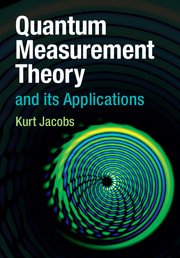Book contents
- Frontmatter
- Dedication
- Contents
- Preface
- 1 Quantum measurement theory
- 2 Useful concepts from information theory
- 3 Continuous measurement
- 4 Statistical mechanics, open systems, and measurement
- 5 Quantum feedback control
- 6 Metrology
- 7 Quantum mesoscopic systems I: circuits and measurements
- 8 Quantum mesoscopic systems II: measurement and control
- Appendix A The tensor product and partial trace
- Appendix B A fast-track introduction for experimentalists
- Appendix C A quick introduction to Ito calculus
- Appendix D Operators for qubits and modes
- Appendix E Dictionary of measurements
- Appendix F Input–output theory
- Appendix G Various formulae and techniques
- Appendix H Some proofs and derivations
- References
- Index
Appendix F - Input–output theory
Published online by Cambridge University Press: 05 September 2014
- Frontmatter
- Dedication
- Contents
- Preface
- 1 Quantum measurement theory
- 2 Useful concepts from information theory
- 3 Continuous measurement
- 4 Statistical mechanics, open systems, and measurement
- 5 Quantum feedback control
- 6 Metrology
- 7 Quantum mesoscopic systems I: circuits and measurements
- 8 Quantum mesoscopic systems II: measurement and control
- Appendix A The tensor product and partial trace
- Appendix B A fast-track introduction for experimentalists
- Appendix C A quick introduction to Ito calculus
- Appendix D Operators for qubits and modes
- Appendix E Dictionary of measurements
- Appendix F Input–output theory
- Appendix G Various formulae and techniques
- Appendix H Some proofs and derivations
- References
- Index
Summary
A mode of an optical or electrical cavity
Input–output theory, developed by Collett and Gardiner in 1984, is a way to treat the interaction of a system with a thermal bath, in which the bath is modeled as a quantum field [128, 199]. It applies to exactly the same situation as that of Lindblad Markovian master equations, such as the Redfield equation, and these master equations can easily be derived from it. But input–output theory goes much further than the equivalent master equations: (i) it allows one to calculate the output that flows from the system into the bath; (ii) it makes the physical connection between thermal baths and continuous measurements; (iii) its derivation avoids the obscure approximations used in the standard derivation of master equations; (iv) it can be used to connect systems together in networks by connecting the outputs of some systems to the inputs of others; (v) more generally the quantum Langevin approach of input–output theory can be applied outside the regime of validity of the Markovian master equations, to explicitly treat open systems in which non-Markovian effects are significant [211, 715].
Input–output theory was originally derived by considering the damping of a mode of an optical cavity. We use this example here in our derivation as a concrete reference, but the theory provides a model for damping and thermalization of any quantum system that is weakly coupled to a large environment. If you are not familiar with the concept of an optical cavity, a quick review is given in Section 3.3. The transmission of light through one of the end-mirrors of the optical cavity will be modeled as an interaction of the cavity mode with the electromagnetic field outside the cavity. In the original treatment the cavity just has two mirrors, and thus the output light comes through the same mirror as the input light. Because of this the electromagnetic field with which the cavity interacts fills only half of the real line (see Fig. F.1). There are other treatments in which the output field goes in the same direction as the input field [100, 669, 686]. While the original method requires a bit more work, we prefer it because it teaches one how to analyze this experimentally natural situation. Our derivation is a pedagogically expanded version of that given by Gardiner and Zoller [201].
- Type
- Chapter
- Information
- Quantum Measurement Theory and its Applications , pp. 458 - 474Publisher: Cambridge University PressPrint publication year: 2014



